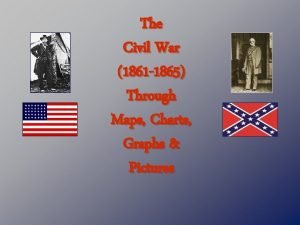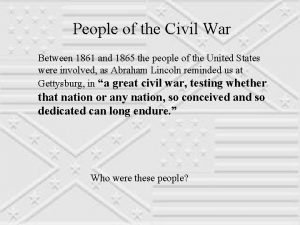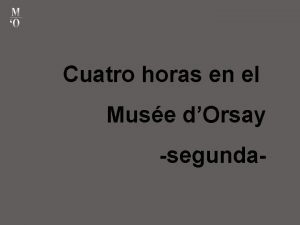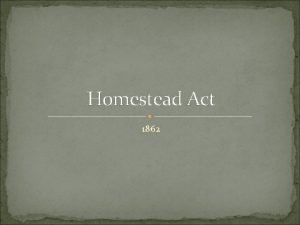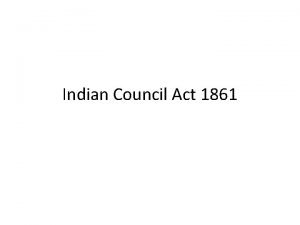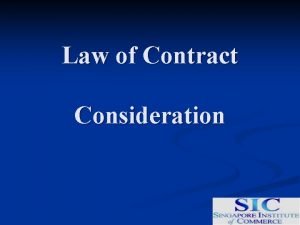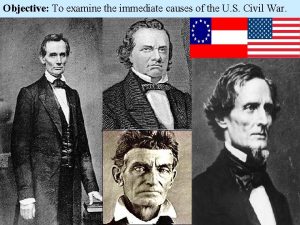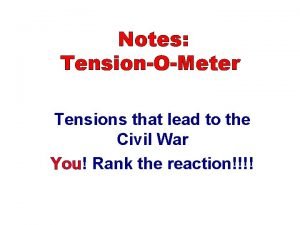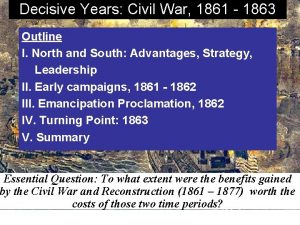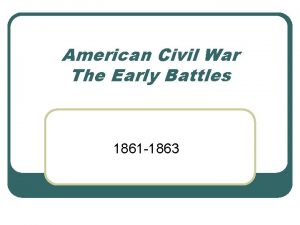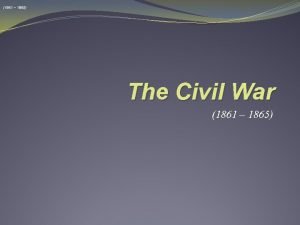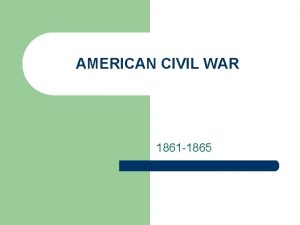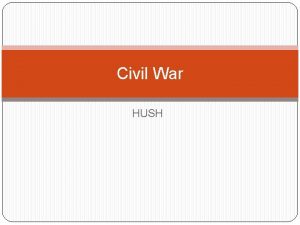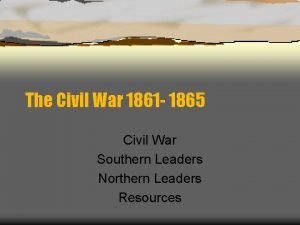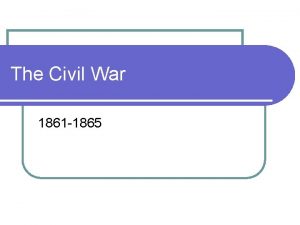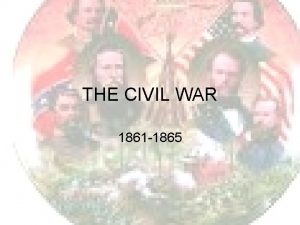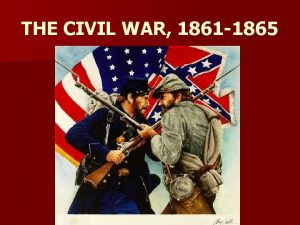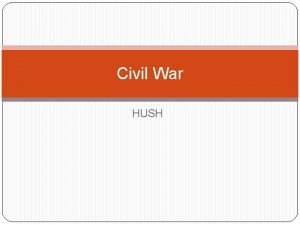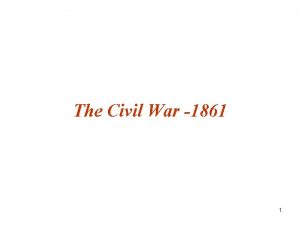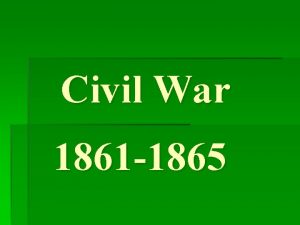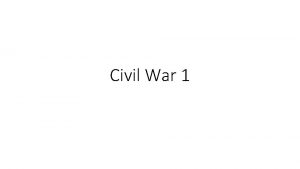The U S Civil War 1861 1863 Student






















- Slides: 22

The U. S. Civil War 1861 -1863 Student Work 4/20 – 4/24

First Battle of Bull Run/Manassas Three months after the bombing of Ft. Sumter, the first land battle of the Civil War took place near a small town in Northern Virginia named Manassas.

First Battle of Bull Run • The U. S. assumed they would win the war easily. In fact, they thought it would take just one battle for the stronger, bigger U. S. army to crush the Confederates. • In July 1861, three months after Ft. Sumter, the Union army attacked the Confederate army near Manassas, VA. The battle begins when Mc. Dowell’s unit attacks Beauregard’s men. Johnston and his men leave the Shenandoah Valley and take the rails to the battlefield site. It is the first time in U. S. history the train is used to deliver troops to a battle.

Battle of Bull Run - midday Mc. Dowell attempts to outflank Beauregard by circling around. Mc. Dowell attacks Beauregard The Confederates were ready for the move. Just arriving on the battlefield Johnston and his men reinforce the left flank.

Battle of Bull Run - afternoon In the center of the Confederate line was Thomas J. Jackson. Though outnumbered he refused to give up the line and held his ground while waiting on reinforcements. The harshest and bloodiest fighting occurs when the armies clash on Henry’s Hill along Bull Run creek. “There stands Jackson like a Stonewall”

Aftermath • The first Battle of Bull Run was the largest and bloodiest battle in U. S. history up to that point. • The Union had 460 killed another 1, 124 wounded. The Confederates had 387 killed and 1, 582 wounded. • The citizens of the U. S. were shocked that their army lost and realized this was going to be more difficult and brutal than expected. Statue of Thomas “Stonewall” Jackson on the Bull Run battlefield today.

Photography and Mathew Brady • The U. S. Civil War was the first war to happen after the invention of photography. • For the first time scenes from battles, and pictures of troops, generals, the wounded, and the carnage were available for citizens to view. • The horrific scenes shocked the public who didn’t realize how messy and deadly war can be. • Mathew Brady was one of the leading photographers of the time. He was well known for doing photographs of U. S. Presidents. During the Civil War he takes photos to document the war. We still use them today to teach the war.


Battle of Shiloh – April 6 -7, 1862 • While the main U. S. Army (the Army of the Potomac) is fighting against Lee in Virginia, there are several major battles in what is called the “Western Theatre” in states along the Mississippi River. • These battles occurred as part of the strategy to divide and conquer the Confederacy. • In April of 1862 one of the bloodiest battles of the Civil War occurred in Western Tennessee at a place named Shiloh.

Battle of Shiloh – April 6 -7, 1862 • The Union with 63, 000 men was led by Ulysses S. Grant, the Confederate army with 40, 300 men was led Albert Sydney Johnston. • In the morning Johnston attacked Grant’s army who didn’t want to engage yet because he was waiting on another portion of his army to arrive. The attack surprised the Union and they were pushed back to the river. • Unfortunately for the Confederates, Johnston was shot in the leg during this stage of the battle. He refused to leave the battlefield, and died from the wound.

Battle of Shiloh – April 6 -7, 1862 • PGT Beauregard took over for the fallen Johnston and continued the assault of the Union. • Some of the most vicious fighting ever seen in warfare took place in the center of the lines in an area nicknamed the “Hornet’s Nest” • At the end of the day, Grant had been pushed back to the river and the Union look defeated, however, Beauregard called off the attack because of nightfall.

Battle of Shiloh – April 6 -7, 1862 • On the night of April 6, Don Buell’s reinforcements finally arrived on the battlefield. • With an extra 15, 000 fresh men ready to fight, Grant launches his attack at dawn. The Confederates were outnumbered and were pushed back until they had to retreat. • The Battle of Shiloh goes down as a major victory for the Union and for Ulysses S. Grant.

Battle of Shiloh – Aftermath • The bloodiest battle in U. S. History at that time. • A combined 23, 000+ casualties in just 2 days of fighting is about the same amount of casualties as the entire U. S. Revolution. • Gives the Union control of Western Tennessee. They will now launch attacks on Mississippi to control the River. • President Lincoln is very impressed with Ulysses S. Grant Tomb of Albert Sydney Johnston in Austin, TX

Second Battle of Bull Run – August 1862 • Fought on almost the same location as the First Battle of Bull Run. • Once again the Confederates, this time led by Robert E. Lee defeat the Union Army led by John Pope despite being outnumbered 50, 000 to 77, 000. • Casualties – Union: 14, 462 Confederates: 7, 298 • With the win, Lee decides to push north and attack the Union.

Battle of Antietam – Sept. 17, 1862 • After winning at Second Bull Run, Lee and his 55, 000 men cross into Maryland. Just 30 miles from Washington D. C. • Union General George Mc. Clellan and his 87, 000 men move to intercept Lee and stop the invasion

Battle of Antietam morning – Union attacks In the morning Mc. Clellan launches the attack trying to use his larger force to run the Confederates off the field. General Hooker pushes the Confederates back, but they are soon reinforced.

Battle of Antietam midmorning – brutal fighting • Confederate soldiers regroup along Antietam Creek, and begin attacking the Union. • Hand to hand combat along the Sunken Road and Bloody Lane see some of the worst fighting of the entire war.

Battle of Antietam afternoon – Lee falls back • The numbers of the Union are too much for the Confederates and they begin to fall back. • Mc. Clellan makes an error in not pursuing Lee, and calls the troops back. Both sides stop fighting because of darkness. • Lee slowly retreats and moves back south

Battle of Antietam - Aftermath • The single bloodiest day in American Military History • 22, 720 combined casualties – in just one day • Though the battle technically ended in a draw, the U. S. claimed victory since Lee left the battlefield first. • Important political victory for the North. With the win Abraham Lincoln will now do something historic…

What should Lincoln do? • The Union blockade was effecting not only the South but the countries of England France as well. • Because England France depended on the raw materials from the Southern U. S. the blockade was hurting their economies. • The two were about to enter the war and fight with the South. • What can Lincoln do to stop England France from joining?

Emancipation Proclamation • President Abraham Lincoln needed to do something to get England France on his side or the U. S. was going to lose the war. • The victory at Antietam, gave Lincoln the political power to issue the Emancipation Proclamation • Emancipate-to free Proclamation-official declaration • On January 1 st, 1863 Abraham Lincoln issues the Emancipation Proclamation officially freeing all the slaves in the U. S. and former territories of the U. S.

Emancipation Proclamation The Emancipation Proclamation did two major things: 1) Slavery was now illegal in the U. S. 2) England France could not join the South or they would be supporting slavery, which had been outlawed in their countries.
 Civil war 1861/1862
Civil war 1861/1862 Civil war 1861/1862
Civil war 1861/1862 Why was the civil war considered the first modern war
Why was the civil war considered the first modern war Chapter 16 lesson 2 challenges to slavery
Chapter 16 lesson 2 challenges to slavery July 1-4 1863
July 1-4 1863 Manet, olympia, 1863
Manet, olympia, 1863 Manet, olympia, 1863
Manet, olympia, 1863 What country did impressionism originated from
What country did impressionism originated from The stonebreakers
The stonebreakers Edouard manet olympia 1863
Edouard manet olympia 1863 Edouard manet olympia 1863
Edouard manet olympia 1863 Jeff wall morning cleaning
Jeff wall morning cleaning Olympia, 1863
Olympia, 1863 Constitucion de 1863
Constitucion de 1863 Hjälper sedan 1863
Hjälper sedan 1863 Nov 19 1863
Nov 19 1863 The three uses of money
The three uses of money Homestead act of 1863
Homestead act of 1863 Indian councils act 1861
Indian councils act 1861 Unionistička stranka 1861
Unionistička stranka 1861 Lush j in currie v. misa
Lush j in currie v. misa South carolina 1861
South carolina 1861 South carolina 1861
South carolina 1861
